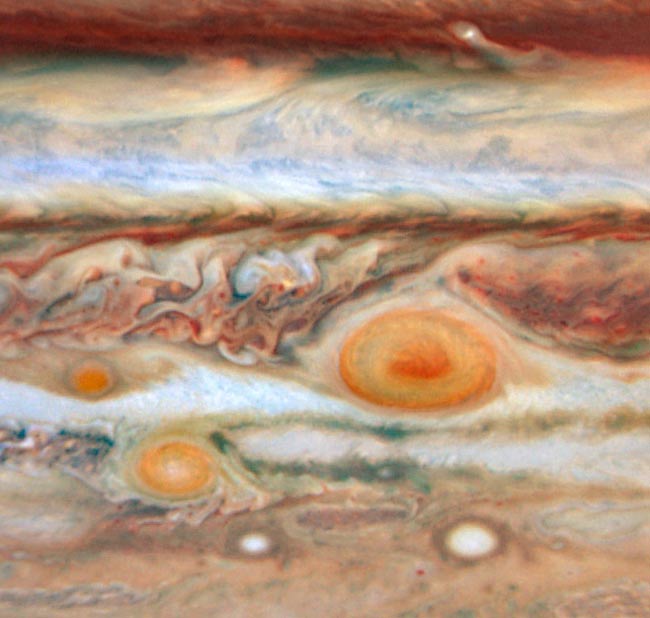Jupiter’s Spots Change Dramatically

A potentially historicchange is occurring on Jupiter. An upstart storm now rivals the gas giant's BigRed Spot as king of storms, astronomers announced last week.
The Little Red Spot, as itwas named upon discovery in 2006, shows both size and speed in threateningto knock the former champion off its perch, with Junior's maximum windsreaching 384 mph (172 meters per second).
"In terms of maximumwind speed, the Little Red Spot as measured in 2007 and the Great Red Spotwhen last measured in 2000 are just about the same," said Andrew Cheng,physicist and lead study author at Johns Hopkins University Applied PhysicsLaboratory in Laurel, Maryland.
Those winds far outstrip the156 mph threshold that defines a Category 5 hurricane on Earth, and the LittleRed Spot itself appears nearly as big as our whole planet.
Seeing spots
A third red spot on Jupiterwas also announcedlast week by a different team, joining its larger super-storm cousins. TheGreat Red Spot has raged on for at least two centuries and perhaps as much as350 years, ancient observations suggest.
Cheng's team used image mapsmade by the New Horizons spacecraft to gauge wind speed and direction. TheHubble Space Telescope provided visible-light images of the storms, while theVery Large Telescope in Chile used mid-infrared to glimpse the thermalstructure of the storms below the visible cloud tops.
Breaking space news, the latest updates on rocket launches, skywatching events and more!
The thermal heat imagesshowed that the Little Red Spot may already match the Great Red Spot for size,although the latter still appears almost twice as large on the surface ofJupiter?s atmosphere when examined in visible light.
"In the infrared, whichsees deeper beneath those clouds, the Little Red Spot appears to be part of aninteracting system that is actually larger than the Great Red Spot," Chengtold SPACE.com.
The Little Red Spot hassteadily gained strength even as the Big Red Spot shrinks. Both storms havewinds that circulate in the opposite direction to that of a cyclone, orcounterclockwise, and appear "strikingly similar," Cheng said.
Seeing red
Astronomers remain mystifiedby the angry red color of the storms. The Little Red Spot only changed color inlate 2005 after it formed from earlier mergers of three smaller storms.Similarly, the newest third red spot began as an oval white storm.
These latest findingssupport the theory that the most powerful storms dredge up material from belowJupiter?s clouds and lift it into the upper atmosphere. That exposes thematerial to solar ultraviolet radiation and causes the color change to red.
The newcomer storm may endup merging with the Great Red Spot or getting pushed away when the two encountereach other in August, assuming their paths remain the same. The Little Red Spotlies at a lower latitude and will pass the Great Red Spot in June.
Such changes in Jupiter'sweather come as part of a global upheaval that began before the NewHorizons spacecraft visited last year. The idea that Jupiter is undergoingglobal climate change was proposed in 2004 by PhilMarcus, a mechanical engineer at the University of California, Berkeley. He predicted large changes in the southern hemisphere starting around 2006 thatwould destabilize jet streams and spawn new storms.
Much of the activity in thegas giant's South Equatorial Belt has disappeared and left the Great Red Spotisolated, foreshadowing even greater changes to come.
"The Great Red Spot maynot always be the largest and strongest storm on Jupiter," said GlennOrton, planetary scientist and study coauthor at NASA's Jet PropulsionLaboratory in Pasadena, Calif.
- Video: Follow New Horizons on its Jupiter Flyby
- The Wildest Weather in the Galaxy
- Image Gallery: Jupiter's Moons
Jeremy Hsu is science writer based in New York City whose work has appeared in Scientific American, Discovery Magazine, Backchannel, Wired.com and IEEE Spectrum, among others. He joined the Space.com and Live Science teams in 2010 as a Senior Writer and is currently the Editor-in-Chief of Indicate Media. Jeremy studied history and sociology of science at the University of Pennsylvania, and earned a master's degree in journalism from the NYU Science, Health and Environmental Reporting Program. You can find Jeremy's latest project on Twitter.
